Sebastian Ruder
AL-QASIDA: Analyzing LLM Quality and Accuracy Systematically in Dialectal Arabic
Dec 05, 2024



Abstract:Dialectal Arabic (DA) varieties are under-served by language technologies, particularly large language models (LLMs). This trend threatens to exacerbate existing social inequalities and limits language modeling applications, yet the research community lacks operationalized LLM performance measurements in DA. We present a method that comprehensively evaluates LLM fidelity, understanding, quality, and diglossia in modeling DA. We evaluate nine LLMs in eight DA varieties across these four dimensions and provide best practice recommendations. Our evaluation suggests that LLMs do not produce DA as well as they understand it, but does not suggest deterioration in quality when they do. Further analysis suggests that current post-training can degrade DA capabilities, that few-shot examples can overcome this and other LLM deficiencies, and that otherwise no measurable features of input text correlate well with LLM DA performance.
M-RewardBench: Evaluating Reward Models in Multilingual Settings
Oct 20, 2024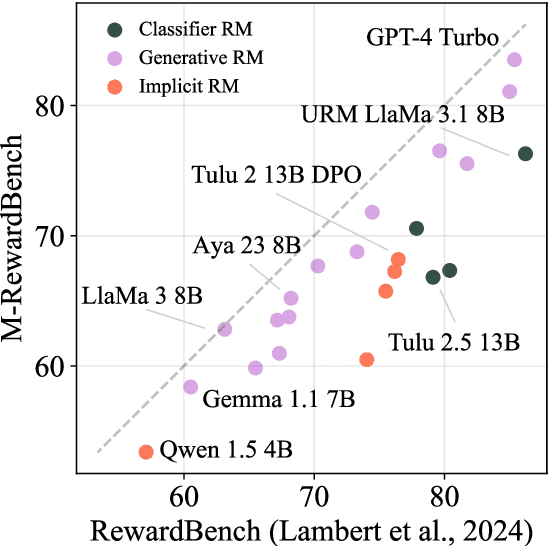



Abstract:Reward models (RMs) have driven the state-of-the-art performance of LLMs today by enabling the integration of human feedback into the language modeling process. However, RMs are primarily trained and evaluated in English, and their capabilities in multilingual settings remain largely understudied. In this work, we conduct a systematic evaluation of several reward models in multilingual settings. We first construct the first-of-its-kind multilingual RM evaluation benchmark, M-RewardBench, consisting of 2.87k preference instances for 23 typologically diverse languages, that tests the chat, safety, reasoning, and translation capabilities of RMs. We then rigorously evaluate a wide range of reward models on M-RewardBench, offering fresh insights into their performance across diverse languages. We identify a significant gap in RMs' performances between English and non-English languages and show that RM preferences can change substantially from one language to another. We also present several findings on how different multilingual aspects impact RM performance. Specifically, we show that the performance of RMs is improved with improved translation quality. Similarly, we demonstrate that the models exhibit better performance for high-resource languages. We release M-RewardBench dataset and the codebase in this study to facilitate a better understanding of RM evaluation in multilingual settings.
BAM! Just Like That: Simple and Efficient Parameter Upcycling for Mixture of Experts
Aug 15, 2024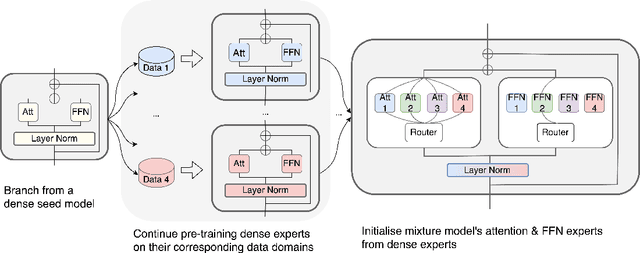
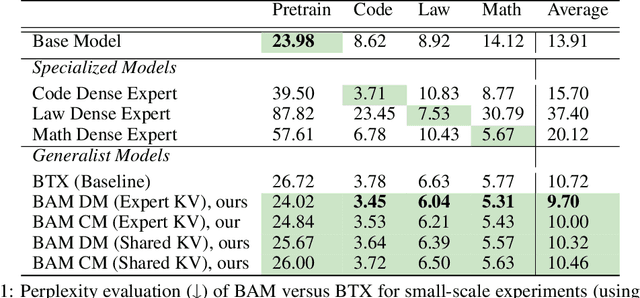
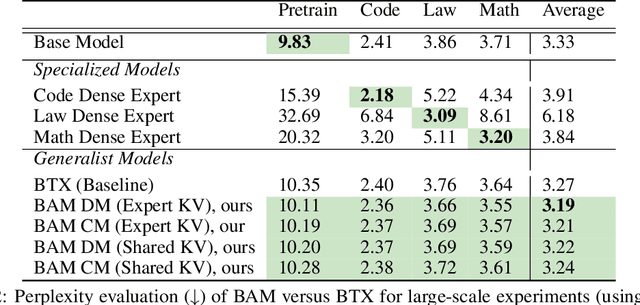
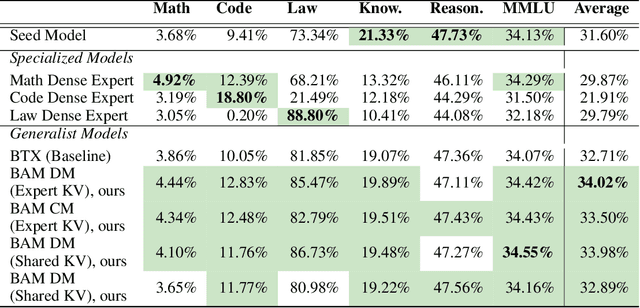
Abstract:The Mixture of Experts (MoE) framework has become a popular architecture for large language models due to its superior performance over dense models. However, training MoEs from scratch in a large-scale regime is prohibitively expensive. Existing methods mitigate this by pre-training multiple dense expert models independently and using them to initialize an MoE. This is done by using experts' feed-forward network (FFN) to initialize the MoE's experts while merging other parameters. However, this method limits the reuse of dense model parameters to only the FFN layers, thereby constraining the advantages when "upcycling" these models into MoEs. We propose BAM (Branch-Attend-Mix), a simple yet effective method that addresses this shortcoming. BAM makes full use of specialized dense models by not only using their FFN to initialize the MoE layers but also leveraging experts' attention parameters fully by initializing them into a soft-variant of Mixture of Attention (MoA) layers. We explore two methods for upcycling attention parameters: 1) initializing separate attention experts from dense models including all attention parameters for the best model performance; and 2) sharing key and value parameters across all experts to facilitate for better inference efficiency. To further improve efficiency, we adopt a parallel attention transformer architecture to MoEs, which allows the attention experts and FFN experts to be computed concurrently. Our experiments on seed models ranging from 590 million to 2 billion parameters demonstrate that BAM surpasses baselines in both perplexity and downstream task performance, within the same computational and data constraints.
How Does Quantization Affect Multilingual LLMs?
Jul 03, 2024Abstract:Quantization techniques are widely used to improve inference speed and deployment of large language models. While a wide body of work examines the impact of quantized LLMs on English tasks, none have examined the effect of quantization across languages. We conduct a thorough analysis of quantized multilingual LLMs, focusing on their performance across languages and at varying scales. We use automatic benchmarks, LLM-as-a-Judge methods, and human evaluation, finding that (1) harmful effects of quantization are apparent in human evaluation, and automatic metrics severely underestimate the detriment: a 1.7% average drop in Japanese across automatic tasks corresponds to a 16.0% drop reported by human evaluators on realistic prompts; (2) languages are disparately affected by quantization, with non-Latin script languages impacted worst; and (3) challenging tasks such as mathematical reasoning degrade fastest. As the ability to serve low-compute models is critical for wide global adoption of NLP technologies, our results urge consideration of multilingual performance as a key evaluation criterion for efficient models.
LLM See, LLM Do: Guiding Data Generation to Target Non-Differentiable Objectives
Jul 01, 2024Abstract:The widespread adoption of synthetic data raises new questions about how models generating the data can influence other large language models (LLMs) via distilled data. To start, our work exhaustively characterizes the impact of passive inheritance of model properties by systematically studying the consequences of synthetic data integration. We provide one of the most comprehensive studies to-date of how the source of synthetic data shapes models' internal biases, calibration and generations' textual attributes and preferences. We find that models are surprisingly sensitive towards certain attributes even when the synthetic data prompts appear "neutral". which invites the question whether this sensitivity can be exploited for good. Our findings invite the question can we explicitly steer the models towards the properties we want at test time by exploiting the data generation process? This would have historically been considered infeasible due to the cost of collecting data with a specific characteristic or objective in mind. However, improvement in the quality of synthetic data, as well as a shift towards general-purpose models designed to follow a diverse way of instructions, means this question is timely. We propose active inheritance as a term to describe intentionally constraining synthetic data according to a non-differentiable objective. We demonstrate how active inheritance can steer the generation profiles of models towards desirable non-differentiable attributes, e.g. high lexical diversity or low toxicity.
Understanding and Mitigating Language Confusion in LLMs
Jun 28, 2024Abstract:We investigate a surprising limitation of LLMs: their inability to consistently generate text in a user's desired language. We create the Language Confusion Benchmark (LCB) to evaluate such failures, covering 15 typologically diverse languages with existing and newly-created English and multilingual prompts. We evaluate a range of LLMs on monolingual and cross-lingual generation reflecting practical use cases, finding that Llama Instruct and Mistral models exhibit high degrees of language confusion and even the strongest models fail to consistently respond in the correct language. We observe that base and English-centric instruct models are more prone to language confusion, which is aggravated by complex prompts and high sampling temperatures. We find that language confusion can be partially mitigated via few-shot prompting, multilingual SFT and preference tuning. We release our language confusion benchmark, which serves as a first layer of efficient, scalable multilingual evaluation at https://github.com/for-ai/language-confusion.
SEACrowd: A Multilingual Multimodal Data Hub and Benchmark Suite for Southeast Asian Languages
Jun 14, 2024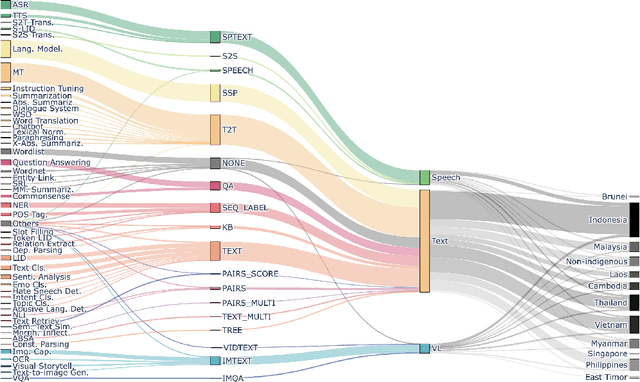
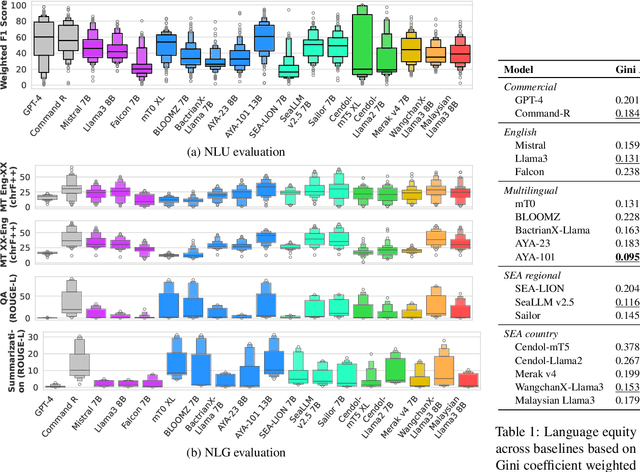
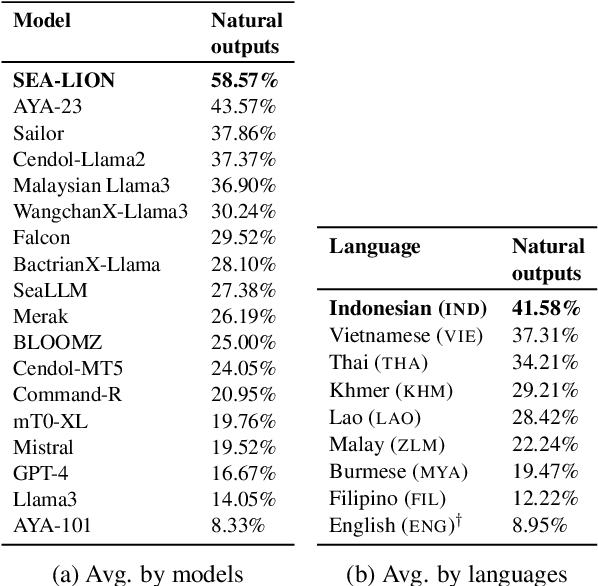
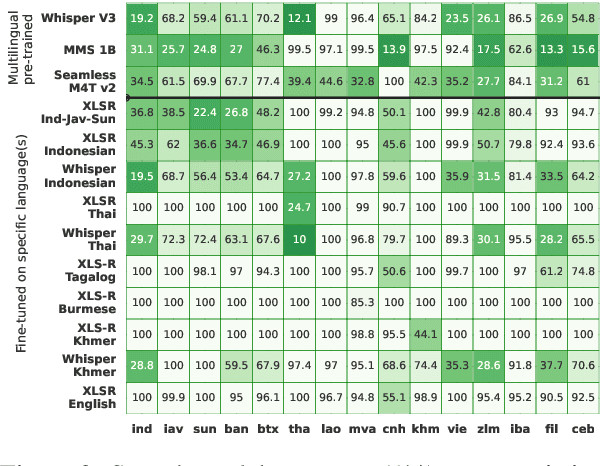
Abstract:Southeast Asia (SEA) is a region rich in linguistic diversity and cultural variety, with over 1,300 indigenous languages and a population of 671 million people. However, prevailing AI models suffer from a significant lack of representation of texts, images, and audio datasets from SEA, compromising the quality of AI models for SEA languages. Evaluating models for SEA languages is challenging due to the scarcity of high-quality datasets, compounded by the dominance of English training data, raising concerns about potential cultural misrepresentation. To address these challenges, we introduce SEACrowd, a collaborative initiative that consolidates a comprehensive resource hub that fills the resource gap by providing standardized corpora in nearly 1,000 SEA languages across three modalities. Through our SEACrowd benchmarks, we assess the quality of AI models on 36 indigenous languages across 13 tasks, offering valuable insights into the current AI landscape in SEA. Furthermore, we propose strategies to facilitate greater AI advancements, maximizing potential utility and resource equity for the future of AI in SEA.
Aya 23: Open Weight Releases to Further Multilingual Progress
May 23, 2024

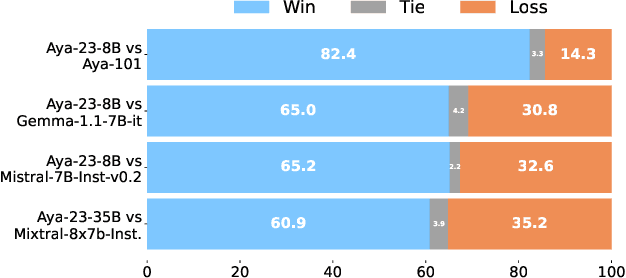

Abstract:This technical report introduces Aya 23, a family of multilingual language models. Aya 23 builds on the recent release of the Aya model (\"Ust\"un et al., 2024), focusing on pairing a highly performant pre-trained model with the recently released Aya collection (Singh et al., 2024). The result is a powerful multilingual large language model serving 23 languages, expanding state-of-art language modeling capabilities to approximately half of the world's population. The Aya model covered 101 languages whereas Aya 23 is an experiment in depth vs breadth, exploring the impact of allocating more capacity to fewer languages that are included during pre-training. Aya 23 outperforms both previous massively multilingual models like Aya 101 for the languages it covers, as well as widely used models like Gemma, Mistral and Mixtral on an extensive range of discriminative and generative tasks. We release the open weights for both the 8B and 35B models as part of our continued commitment for expanding access to multilingual progress.
Aya Dataset: An Open-Access Collection for Multilingual Instruction Tuning
Feb 09, 2024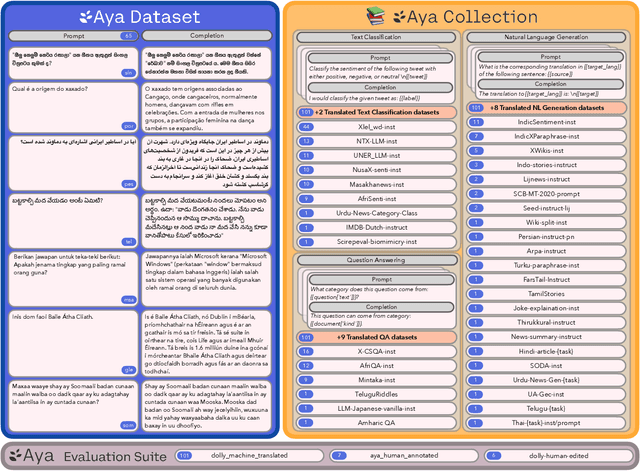
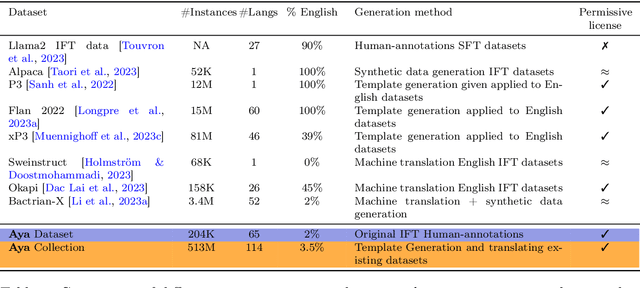
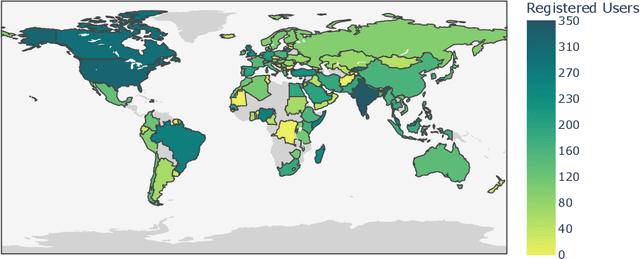
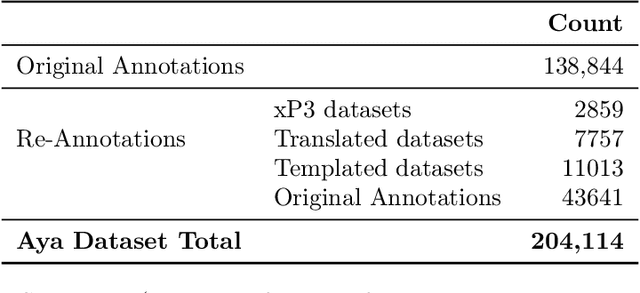
Abstract:Datasets are foundational to many breakthroughs in modern artificial intelligence. Many recent achievements in the space of natural language processing (NLP) can be attributed to the finetuning of pre-trained models on a diverse set of tasks that enables a large language model (LLM) to respond to instructions. Instruction fine-tuning (IFT) requires specifically constructed and annotated datasets. However, existing datasets are almost all in the English language. In this work, our primary goal is to bridge the language gap by building a human-curated instruction-following dataset spanning 65 languages. We worked with fluent speakers of languages from around the world to collect natural instances of instructions and completions. Furthermore, we create the most extensive multilingual collection to date, comprising 513 million instances through templating and translating existing datasets across 114 languages. In total, we contribute four key resources: we develop and open-source the Aya Annotation Platform, the Aya Dataset, the Aya Collection, and the Aya Evaluation Suite. The Aya initiative also serves as a valuable case study in participatory research, involving collaborators from 119 countries. We see this as a valuable framework for future research collaborations that aim to bridge gaps in resources.
Gemini: A Family of Highly Capable Multimodal Models
Dec 19, 2023Abstract:This report introduces a new family of multimodal models, Gemini, that exhibit remarkable capabilities across image, audio, video, and text understanding. The Gemini family consists of Ultra, Pro, and Nano sizes, suitable for applications ranging from complex reasoning tasks to on-device memory-constrained use-cases. Evaluation on a broad range of benchmarks shows that our most-capable Gemini Ultra model advances the state of the art in 30 of 32 of these benchmarks - notably being the first model to achieve human-expert performance on the well-studied exam benchmark MMLU, and improving the state of the art in every one of the 20 multimodal benchmarks we examined. We believe that the new capabilities of Gemini models in cross-modal reasoning and language understanding will enable a wide variety of use cases and we discuss our approach toward deploying them responsibly to users.
 Add to Chrome
Add to Chrome Add to Firefox
Add to Firefox Add to Edge
Add to Edge